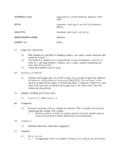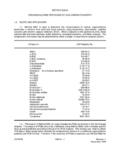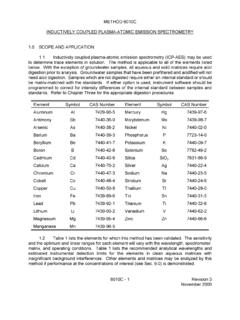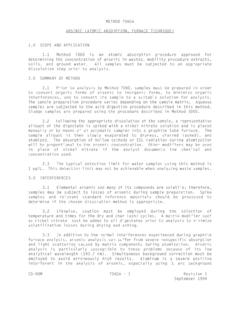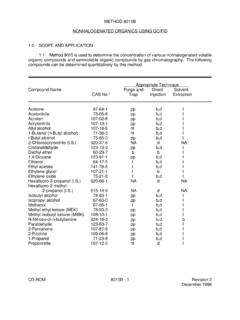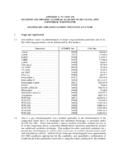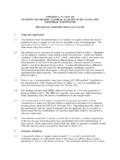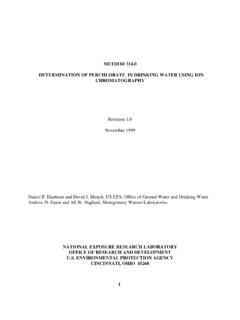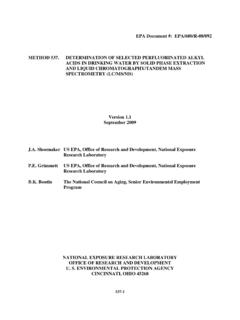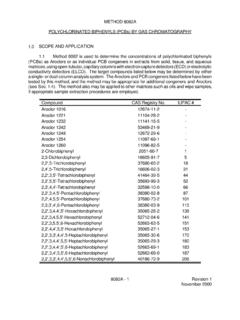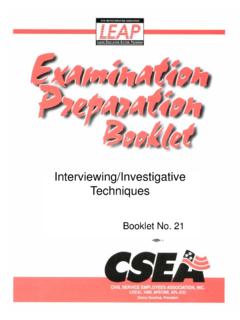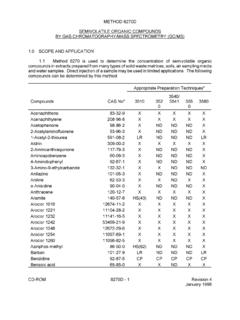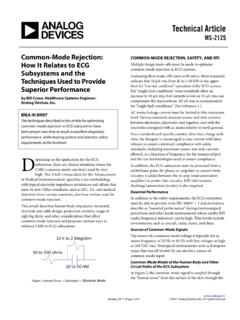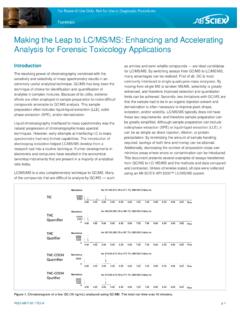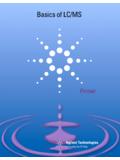Transcription of METHOD 8260B VOLATILE ORGANIC …
1 METHOD 8260B . VOLATILE ORGANIC COMPOUNDS BY GAS CHROMATOGRAPHY/. mass spectrometry (GC/MS). SCOPE AND APPLICATION. METHOD 8260 is used to determine VOLATILE ORGANIC compounds in a variety of solid waste matrices. This METHOD is applicable to nearly all types of samples, regardless of water content, including various air sampling trapping media, ground and surface water, aqueous sludges, caustic liquors, acid liquors, waste solvents, oily wastes, mousses, tars, fibrous wastes, polymeric emulsions, filter cakes, spent carbons, spent catalysts, soils, and sediments. The following compounds can be determined by this METHOD : Appropriate Preparation Techniquea 5030/ Direct compound CAS 5035 5031 5032 5021 5041 Inject.
2 Acetone 67-64-1 pp c c nd c c Acetonitrile 75-05-8 pp c nd nd nd c Acrolein (Propenal) 107-02-8 pp c c nd nd c Acrylonitrile 107-13-1 pp c c nd c c Allyl alcohol 107-18-6 ht c nd nd nd c Allyl chloride 107-05-1 c nd nd nd nd c Benzene 71-43-2 c nd c c c c Benzyl chloride 100-44-7 c nd nd nd nd c Bis(2-chloroethyl)sulfide 505-60-2 pp nd nd nd nd c Bromoacetone 598-31-2 pp nd nd nd nd c Bromochloromethane 74-97-5 c nd c c c c Bromodichloromethane 75-27-4 c nd c c c c 4-Bromofluorobenzene (surr) 460-00-4 c nd c c c c Bromoform 75-25-2 c nd c c c c Bromomethane 74-83-9 c nd c c c c n-Butanol 71-36-3 ht c nd nd nd c 2-Butanone (MEK) 78-93-3 pp c c nd nd c t-Butyl alcohol 75-65-0 pp c nd nd nd c Carbon disulfide 75-15-0 pp nd c nd c c Carbon tetrachloride 56-23-5 c nd c c c c Chloral hydrate 302-17-0 pp nd nd nd nd c Chlorobenzene 108-90-7 c nd c c c c Chlorobenzene-d5 (IS)
3 C nd c c c c Chlorodibromomethane 124-48-1 c nd c nd c c Chloroethane 75-00-3 c nd c c c c 2-Chloroethanol 107-07-3 pp nd nd nd nd c 2-Chloroethyl vinyl ether 110-75-8 c nd c nd nd c Chloroform 67-66-3 c nd c c c c Chloromethane 74-87-3 c nd c c c c Chloroprene 126-99-8 c nd nd nd nd c 3-Chloropropionitrile 542-76-7 I nd nd nd nd pc (continued). CD-ROM 8260B - 1 Revision 2. December 1996. Appropriate Preparation Techniquea 5030/ Direct compound CAS 5035 5031 5032 5021 5041 Inject. Crotonaldehyde 4170-30-3 pp c nd nd nd c 1,2-Dibromo-3-chloropropane 96-12-8 pp nd nd c nd c 1,2-Dibromoethane 106-93-4 c nd nd c nd c Dibromomethane 74-95-3 c nd c c c c 1,2-Dichlorobenzene 95-50-1 c nd nd c nd c 1,3-Dichlorobenzene 541-73-1 c nd nd c nd c 1,4-Dichlorobenzene 106-46-7 c nd nd c nd c 1,4-Dichlorobenzene-d4 (IS)
4 C nd nd c nd c cis-1,4-Dichloro-2-butene 1476-11-5 c nd c nd nd c trans-1,4-Dichloro-2-butene 110-57-6 pp nd c nd nd c Dichlorodifluoromethane 75-71-8 c nd c c nd c 1,1-Dichloroethane 75-34-3 c nd c c c c 1,2-Dichloroethane 107-06-2 c nd c c c c 1,2-Dichloroethane-d4 (surr) c nd c c c c 1,1-Dichloroethene 75-35-4 c nd c c c c trans-1,2-Dichloroethene 156-60-5 c nd c c c c 1,2-Dichloropropane 78-87-5 c nd c c c c 1,3-Dichloro-2-propanol 96-23-1 pp nd nd nd nd c cis-1,3-Dichloropropene 10061-01-5 c nd c nd c c trans-1,3-Dichloropropene 10061-02-6 c nd c nd c c 1,2,3,4-Diepoxybutane 1464-53-5 c nd nd nd nd c Diethyl ether 60-29-7 c nd nd nd nd c 1,4-Difluorobenzene (IS)
5 540-36-3 nd nd nd nd c nd 1,4-Dioxane 123-91-1 pp c c nd nd c Epichlorohydrin 106-89-8 I nd nd nd nd c Ethanol 64-17-5 I c c nd nd c Ethyl acetate 141-78-6 I c nd nd nd c Ethylbenzene 100-41-4 c nd c c c c Ethylene oxide 75-21-8 pp c nd nd nd c Ethyl methacrylate 97-63-2 c nd c nd nd c Fluorobenzene (IS) 462-06-6 c nd nd nd nd nd Hexachlorobutadiene 87-68-3 c nd nd c nd c Hexachloroethane 67-72-1 I nd nd nd nd c 2-Hexanone 591-78-6 pp nd c nd nd c 2-Hydroxypropionitrile 78-97-7 I nd nd nd nd pc Iodomethane 74-88-4 c nd c nd c c Isobutyl alcohol 78-83-1 pp c nd nd nd c Isopropylbenzene 98-82-8 c nd nd c nd c Malononitrile 109-77-3 pp nd nd nd nd c Methacrylonitrile 126-98-7 pp I nd nd nd c Methanol 67-56-1 I c nd nd nd c Methylene chloride 75-09-2 c nd c c c c Methyl methacrylate 80-62-6 c nd nd nd nd c 4-Methyl-2-pentanone (MIBK)
6 108-10-1 pp c c nd nd c Naphthalene 91-20-3 c nd nd c nd c (continued). CD-ROM 8260B - 2 Revision 2. December 1996. Appropriate Preparation Techniquea 5030/ Direct compound CAS 5035 5031 5032 5021 5041 Inject. Nitrobenzene 98-95-3 c nd nd nd nd c 2-Nitropropane 79-46-9 c nd nd nd nd c N-Nitroso-di-n-butylamine 924-16-3 pp c nd nd nd c Paraldehyde 123-63-7 pp c nd nd nd c Pentachloroethane 76-01-7 I nd nd nd nd c 2-Pentanone 107-87-9 pp c nd nd nd c 2-Picoline 109-06-8 pp c nd nd nd c 1-Propanol 71-23-8 pp c nd nd nd c 2-Propanol 67-63-0 pp c nd nd nd c Propargyl alcohol 107-19-7 pp I nd nd nd c $-Propiolactone 57-57-8 pp nd nd nd nd c Propionitrile (ethyl cyanide)
7 107-12-0 ht c nd nd nd pc n-Propylamine 107-10-8 c nd nd nd nd c Pyridine 110-86-1 I c nd nd nd c Styrene 100-42-5 c nd c c c c 1,1,1,2-Tetrachloroethane 630-20-6 c nd nd c c c 1,1,2,2-Tetrachloroethane 79-34-5 c nd c c c c Tetrachloroethene 127-18-4 c nd c c c c Toluene 108-88-3 c nd c c c c Toluene-d8 (surr) 2037-26-5 c nd c c c c o-Toluidine 95-53-4 pp c nd nd nd c 1,2,4-Trichlorobenzene 120-82-1 c nd nd c nd c 1,1,1-Trichloroethane 71-55-6 c nd c c c c 1,1,2-Trichloroethane 79-00-5 c nd c c c c Trichloroethene 79-01-6 c nd c c c c Trichlorofluoromethane 75-69-4 c nd c c c c 1,2,3-Trichloropropane 96-18-4 c nd c c c c Vinyl acetate 108-05-4 c nd c nd nd c Vinyl chloride 75-01-4 c nd c c c c o-Xylene 95-47-6 c nd c c c c m-Xylene 108-38-3 c nd c c c c p-Xylene 106-42-3 c nd c c c c a See Sec.
8 For other appropriate sample preparation techniques b Chemical Abstract Service Registry Number c = Adequate response by this technique ht = METHOD analyte only when purged at 80EC. nd = Not determined I = Inappropriate technique for this analyte pc = Poor chromatographic behavior pp = Poor purging efficiency resulting in high Estimated Quantitation Limits surr = Surrogate IS = Internal Standard CD-ROM 8260B - 3 Revision 2. December 1996. There are various techniques by which these compounds may be introduced into the GC/MS system. The more common techniques are listed in the table above. Purge-and-trap, by methods 5030 (aqueous samples) and 5035 (solid and waste oil samples), is the most commonly used technique for VOLATILE ORGANIC analytes.
9 However, other techniques are also appropriate and necessary for some analytes. These include direct injection following dilution with hexadecane ( METHOD 3585) for waste oil samples; automated static headspace by METHOD 5021 for solid samples; direct injection of an aqueous sample (concentration permitting) or injection of a sample concentrated by azeotropic distillation ( METHOD 5031); and closed system vacuum distillation ( METHOD 5032) for aqueous, solid, oil and tissue samples. For air samples, METHOD 5041 provides methodology for desorbing VOLATILE organics from trapping media ( methods 0010, 0030, and 0031).
10 In addition, direct analysis utilizing a sample loop is used for sub-sampling from Tedlar bags ( METHOD 0040). METHOD 5000 provides more general information on the selection of the appropriate introduction METHOD . METHOD 8260 can be used to quantitate most VOLATILE ORGANIC compounds that have boiling points below 200EC. VOLATILE , water soluble compounds can be included in this analytical technique by the use of azeotropic distillation or closed-system vacuum distillation. Such compounds include low molecular weight halogenated hydrocarbons, aromatics, ketones, nitriles, acetates, acrylates, ethers, and sulfides.
